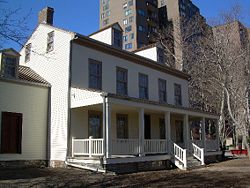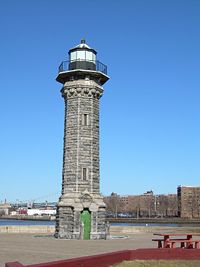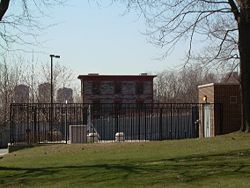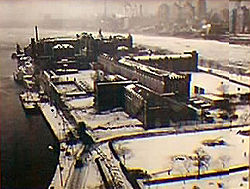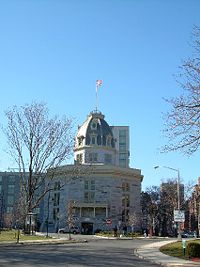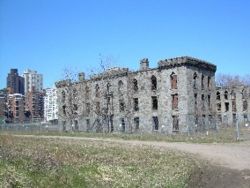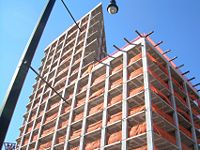From The Peopling of New York City
Contents |
History & Community
A Brief Overview
In 1637,[1] the island then known as "Minnahononck" was purchased from the Native Americans by the Dutch governor Wouter Van Twiller. It was renamed Varcken Island, which is Dutch for "Hog Island", due to the hogs that were raised there. In 1666, it was purchased by the British captain John Manning, and became known as Manning's Island, but in 1673 it was surrendered back to the Dutch. In 1686, Manning's son-in-law, Robert Blackwell, gained control over the island, whereupon its name became Blackwell's Island. Blackwell lived there until his death in 1717.
In 1782, the island was put up for sale, but with no takers. In 1794 the famed Blackwell House was built, which remains today as the oldest structure on the island. Finally on July 18, 1828, the City of New York purchased Blackwell's Island, with the intention of using it as a space for charitable and correctional institutions. The city erected a penitentiary, and soon after, in 1832, the city opened the New York Lunatic Asylum, which included the famous Octagon Tower, which has been renovated and is now the centerpiece of a new apartment complex. In 1852, the Smallpox Hospital was built, and its ruins can still be seen today. In 1872, the Gothic-style lighthouse at the northern tip of the island was built. In 1889, another landmark was constructed, the Chapel of the Good Shepherd. A few years later, in 1892, yet another landmark opened; the Strecker Laboratory, which became the premier pathology lab in the city during its time.In 1921, the island is renamed Welfare Island. Upon the opening of the penitentiary on Rikers Island in 1935, all remaining priosners on Welfare Island were relocated there. In 1939, Goldwater Memorial Hospital opens as a chronic care and nursing facility, which was soon followed by the opening of a similar facility, the Bird S. Coler Hospital. The hospitals have since merged.
In 1955, the Welfare Island Bridge, connecting the island to Queens, opens. In 1968, the current mayor John Lindsay, appointed a committee to plan major development for the island. A year later, the Urban Development Corporation created a plan to construct some 5,000 apartments to house approximately 20,000 people. In 1973, the island received its current name, Roosevelt Island. Over the next few years, apartment complexes began to spring up. In 1976, the iconic Tramway opened, at first as a temporary transportation solution until the Roosevelt Island subway stop was constructed. The tram, however, quickly became the symbol of the island and remained in operation. In 1984, the Roosevelt Island Operating Commission (RIOC), was formed, and in 1989, thirteen years later, the subway stop for the island opened.
The Darker Side of Roosevelt Island
Blackwell's Penitentiary
New York City acquired Blackwell's Island in 1828 with the intention of using it for correctional facilities. In 1832, Blackwell's Penitentiary was erected using stone from the island, costing $16,596.[2] In 1852, the Blackwell's Workhouse was constructed, containing 221 cells arranged in tiers along the three-story walls of granite. The building functioned as an institution for punishment of petty violators, many of whom were classified as habitual "drunks and disorderlies," including several who virtually became permanent residents even though the usual stays were counted in days. The 600 foot long, four story tall penitentiary had a total of 800 cells. Scandals involving overcrowding, drugs, and favoritism defined the penitentiary's history of misery.Finally, in 1934, during a period of reform led by Mayor Fiorello LaGuardia, the conditions of the prison were exposed, leading to its subsequent demolition, and transfer of all inmates to Rikers Island.[3]
New York Lunatic Asylum
Opened in 1839, the Lunatic Asylum, including its famous octagon-shaped tower, began operating in response to the need for proper accomodation for the insane. The asylum was severely understaffed and underfinanced, leading to many complications. Disease plagued both the patients and staff.[4] In 1842, Charles Dickens visited the asylum. The following is an excerpt from his "American Notes" regarding the asylum:"Everything had a very lounging, listless, madhouse air, which was very painful. The moping idiot, cowering down with long disheveled hair; the gibbering maniac, with his hideous laugh and pointed finger; the vacant eye, the fierce wild face, the gloomy picking of the hands and lips, and munching of the nails: there they were all, without disguise, in naked ugliness and horror."[5]
In 1894, the city realized the inadequate care that was being given to the mentally ill, and converted the asylum into a general hospital. In the 1950's the building was abandoned, and although faced with the threat of demolition, was in the end preserved. In 2004, the long-awaited construction of the Octagon Apartments, a new luxury development in and around the ruins of the old asylum, began.
Click below to listen to interviews conducted by Richard Hake of WNYC radio, regarding the lunatic asylum's conversion into residential space.
Smallpox Hospital
Between 1854 and 1856, the island's Smallpox Hospital was built in order to deal with the smallpox epidemic at the time. The Gothic-style building was designed by James Renwick, Jr. The hospital accomodated 100 patients. In 1875 the building was converted into housing for nurses, and by the 1950's, like most of the island's other institutions, the building was abandoned, and quickly lay to ruin. Today the haunting ruins that remain are known as the "Renwick Ruins",and is one of the most popular attractions on the island.[6]
Roosevelt Island Today
Meet a Local: Judy BerdyJudy is the director of the Roosevelt Island Historical Society and has been living on the island since 1977. She moved here for the simple reason that "it's affordable". She doesn't feel in the least bit isolated from the rest of the city and says that the island is "a real small town".
Housing
Roosevelt Island today consists mostly of large apartment complexes that offer very affordable housing primarily to middle-income families. There are a total of eight complexes on the island. Most of the buildings are subsidized under the Mitchell Lama Housing Program, and the waiting list for an apartment is long. Even buildings such as the Octagon, which caters to market-rate seeking individuals, reserves one-fifth of its 500 units for middle-income families. Otherwise, market-rate rentals are available in complexes such as "Manhattan Park", ranging in price from $1,695 for a one bedroom, and $3,395 for a four bedroom. [7]Fear for the Future
There are only about 900 market-rate apartments available out of a total of some 3,000 units. Many residents, however, fear that this will soon change. Under the Mitchell-Lama program, building owners are required to keep a price cap on rents in exchange for low-interest mortgages and tax abatements. Owners, however, may take their buildings off the program after twenty years if the mortgage is paid off. The national trends, and especially in Manhattan, is that of privatization. Such privatization is greatly feared by residents, who feel threatened at the thought of expensive, market-rate housing destroying the unique diverse, small-town atmosphere that permeates the island. Many developers are arguing that they would never have agreed to be placed under the Mitchell-Lama program except for the fact that the price cap expires after twenty years. In the mean time, the Roosevelt Island Residents Association has planned a mass rally to Albany in support of extending rent-control policies in expired Mitchell-Lama buildings.[8]
Roosevelt Island Operating Corporation
Roosevelt Island is unique in that in many ways it operates independently of the rest of the city. The Roosevelt Island Operating Corporation (RIOC) is a political subdivison of the State of New York, and was created in 1984 to maintain the development and operation of the island. The corporation is designed to "supplement" the services provided by the City of New York, and consists of a nine-member board.[9] The corporation is in charge of the operation of both the tram and bus system on the island. It also runs the Roosevelt Island Public Safety Department, a neighborhood patrol force.Other Info
There are only a handful of Local Businesses on the island. There is one elementary school, P.S. 217. Island teens must attend high school in either Manhattan or Queens.[10] The island is part of the 114th precint of the NYPD, which also covers part of Queens, making it difficult to obtain crime statistics for the island. The general consesus, however, is that crime is very low.[11] A free, community newspaper entitled "The Wire" serves the island. The island is home to Coler-Goldwater Memorial Hospital, which specializes in long-term rehabilitative care.[12] The island is also abundant in sports activities, with numerous soccer fields, baseball diamonds, basketball courts and even an indoor sports complex that houses an olympic-sized swimming pool. Although the island is visibly undergoing some big changes in terms of development, it still very much retains its own slow-paced quiet, style that has been attracting its many long-time residents for decades.Notes
- ↑ [1] All facts in the brief overview are taken from the "Timeline of Roosevelt Island History" on "The Wire's" website, www.nyc10044.com
- ↑ [2] "The Wire": Timeline of Roosevelt Island History"
- ↑ [3] New York Correction History Society
- ↑ [4] Roosevelt Island Historical Society
- ↑ [5] www.wnyc.org, "Former Lunatic Asylum Goes Luxury Rental", by Richard Hake
- ↑ [6] Roosevelt Island Historical Society
- ↑ [7]Wilson, Mollie. Village Voice, A Close-Up on Roosevelt Island, April 27, 2004
- ↑ [8] Beyond Manhattan: New York's Other Islands. Rodriguez-Nava, Gabriel. Residents Fear Expiration of Housing Program
- ↑ [9] Roosevelt Island Operating Corporation
- ↑ [10] Insideschools.org
- ↑ [11] Village Voice, 2004.
- ↑ [[12]] New York City Health and Hospitals Corportation
Click here to return to the home page
